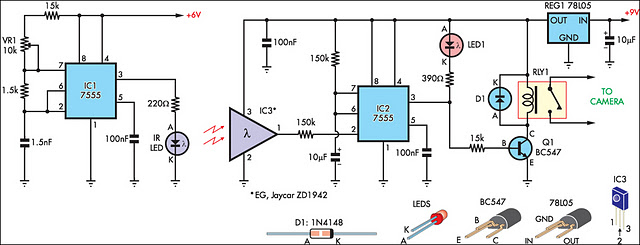Home » Circuits
Beam-break Detector For Camera Shutter or Flash Control
This circuit is presented as an alternative to the IR beam break detector featured in the June 2009 issue (Silicon Chip). In order to make it relatively insensitive to ambient light, it uses a standard IR receiver IC such as the Jaycar ZD-1942. This has a high output (+5V) as long as a modulated beam is detected.The IR detector (IC3) controls an LM7555 CMOS timer (IC2) which operates in monostable mode. When the beam is broken, IC2 is triggered and its pin 3 output goes high for about half a second. This extinguishes LED1 and turns on transistor Q1 to drive a 5V low-power relay.
The circuit is powered from six AA cells and a 78L05 5V regulator (necessary for the receiver IC). The IR transmitter is also built around an LM7555 (IC1), this time operating in astable mode at low duty cycle. Its frequency is set to 38kHz with trimpot VR1. The IR diode was salvaged from a defunct remote control but these are readily available new. The transmitter is powered by four AA cells.
The system has a range of several metres and while it is insensitive to the transmitter alignment, the detection window can be narrowed by placing the detector near to the object to be detected and/or using some form of baffle to restrict the window.
Circuit diagram:
Source: Silicon Chip 14 March 2010

